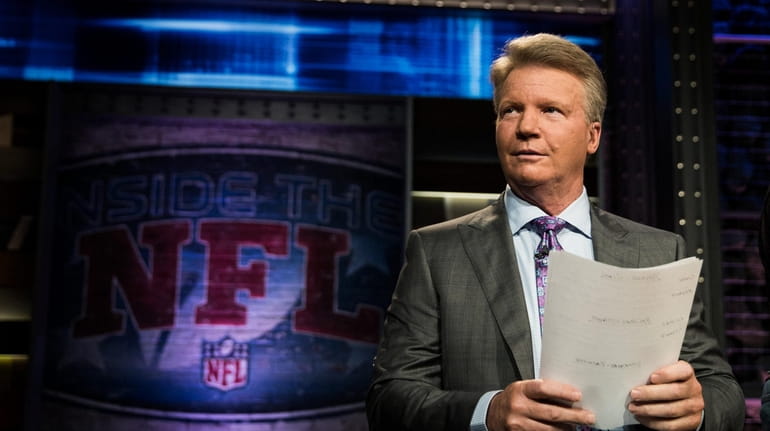Phil Simms breaks down game tape of Super Bowl III: The Jets dominated!

Phil Simms on the set of Showtime's "Inside the NFL." Credit: Amanda Westcott/SHOWTIME
“The Jets whupped them,” Phil Simms said. “I’m really shocked . . . They beat ’em up.”
This was at Simms’ New Jersey home on Wednesday after he had time-traveled 50 years back to Jan. 12, 1969.
At Newsday’s request, the MVP of New York’s second Super Bowl victory watched New York’s first and tried to explain how the biggest upset in the game’s history happened.
What Simms, the Giants’ quarterback in Super Bowl XXI and now an analyst for CBS, saw on a scratchy DVD of Super Bowl III at first seemed to be a fluky game in which the Jets took advantage of early Colts mistakes, including Earl Morrall throwing three interceptions in Jets territory and two missed field goals in the first half.
But as the second half wore on, players’ jerseys became caked in mud and the mighty NFL champions — nearly three-touchdown favorites — grew increasingly frustrated, Simms saw something else: That the superior team won, 16-7.
“The Jets ripped their butt here in the second half,” Simms said. “I don’t remember it this way. It’s amazing.”
This was not the first time Simms had seen the game. He watched it live as a 13-year-old. Then, in the mid-1980s, Giants general manager George Young, a Colts assistant coach at that Super Bowl, invited Simms to watch the coaches’ film with him.
“He was still mad about it,” Simms said with a laugh.
But now he was watching with the perspective of five decades of football history, and as someone who follows a modern game that bears little resemblance to what it was before men walked on the moon. Simms marveled at everything from the more modest dimensions of players to the lack of things we now take for granted such as multiple alignments, shotgun formations, players in motion, personnel changes and the like.
(Among the exceptions to the smaller players was Colts tight end John Mackey, who was from Hempstead. “John Mackey has the size and speed of today’s NFL player,” Simms said.)
There are numerous other quirks, such as backs not staying in to help with blitz pickups, the Jets’ featured back, Matt Snell, making a tackle in punt coverage and assorted mayhem such as the Colts’ Tom Mitchell — who was not in the game at the time — clobbering Johnny Sample from behind with his helmet on the sideline. No penalty was called.
Then there was the rudimentary NBC telecast, featuring Curt Gowdy on play-by-play and minimal analysis from Al DeRogatis. (The DVD was from an NFL Network replay of the game in 2007.)
Early on, Simms was surprised by the quickness and athleticism of many players. He also imagined what people watching in 1969 would have thought as the Colts trailed only 7-0 at halftime despite their mistakes. “If you and I were watching this game right now live, we’d be going, ‘Man, Baltimore really looks like the better team,’ ” he said.
The Colts had won 14 of 15 games — allowing 10 or fewer points in 11 of them — and were coming off a 34-0 rout of the Browns in the NFL Championship Game. But as the game wore on, the Colts wore out.
Joe Namath, who was named MVP, finished 17-for-28 passing for 206 yards, Snell rushed 30 times for 121 yards and a touchdown and right tackle Dave Herman neutralized the Colts’ star end, Bubba Smith
The few who thought Joe Namath’s Jets had a chance figured they would turn the game into an AFL-style shootout. Instead, they grinded it out against what was supposed to be a fearsome run defense. Namath took a few deep shots aimed at future Hall of Famer Don Maynard, but Maynard was shut out. George Sauer caught eight passes for 133 yards.
The fact that the Jets prevailed that way impressed Simms even more. He said modern schemes are so sophisticated that sometimes an inferior team can win by out-coaching the opponent.
Not so 50 years ago, when tendencies were so obvious that Simms almost always was able to predict what was coming.
“I don’t think they cared,” he said. “ . . . It wasn’t like ‘we’re going to try to deceive people’ . . . It’s just about who’s the better player.”
Simms said he is glad he was not a game analyst in that era, because there was not much to analyze. Gowdy and DeRogatis mostly downplayed the historic implications until late in the game, after Johnny Unitas had come off the bench to lead a late touchdown drive. But the Jets knew what they had accomplished and knew they had proved what they kept telling anyone who would listen: that they were the better team.

